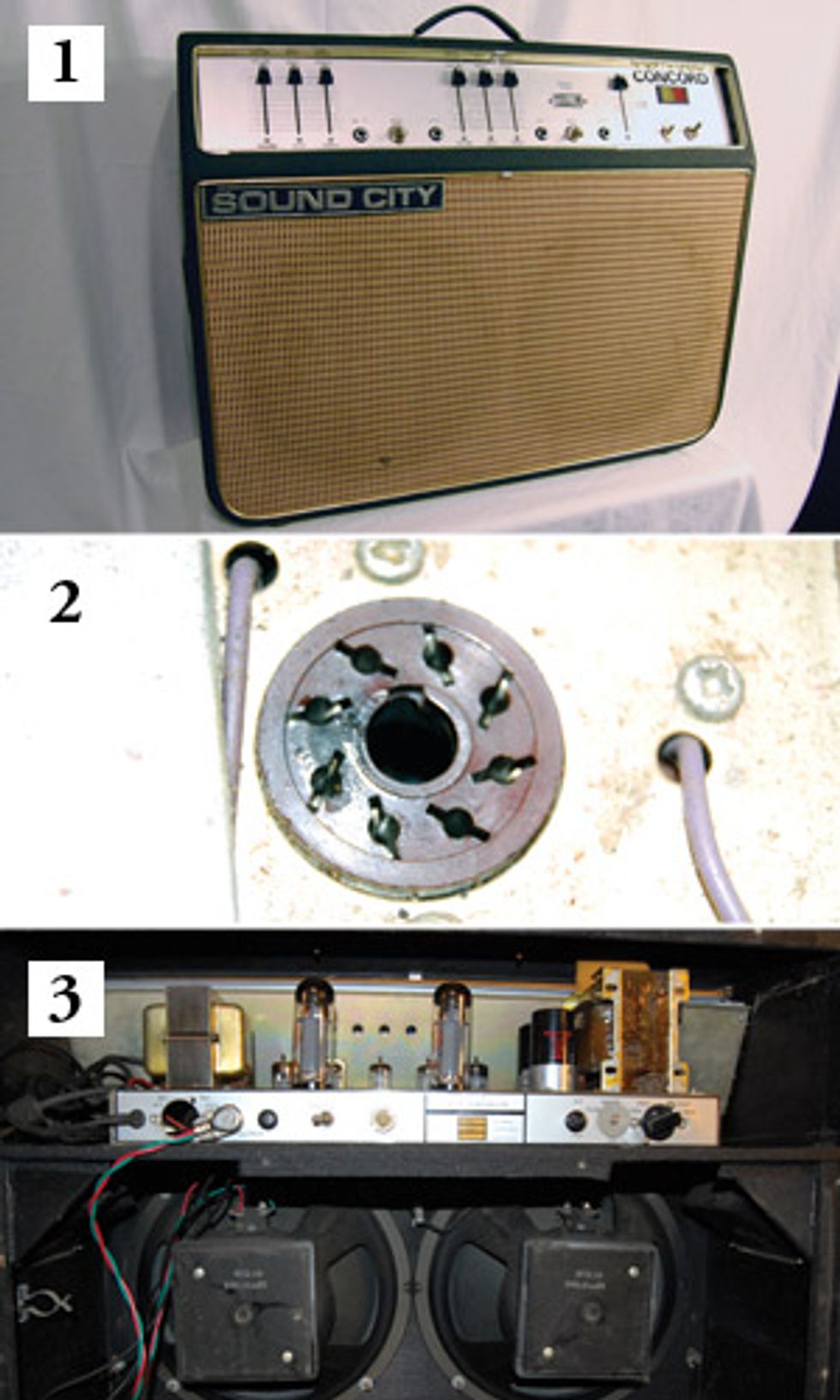
1. The rare Sound City Concord. This dual EL34 2x12 combo even sports an output level meter. 2. Yow! This tube socket has high-voltage burn marks between the pins, so it will need to be replaced. 3. The view from behind reveals a pair of square-magnet Eminence 12s with manufacturing date codes from 1972.
This month, rather than answer one of your questions (which, by the way, I am very thankful for and look forward to), I’m going to dedicate this column to a project that’s been on the back burner for a while. Okay—10 or 15 years, but who’s counting?
A customer brought this amp to me for repair and I don’t remember if it had been given to him after it failed or if the failure occurred while he owned it, but after seeing the damage he decided that it was simply not worth the effort and expense to bring the beast back to life. Not living near a landfill, he left it with me to use as a boat anchor. Seeing as how I didn’t own a boat, I initially thought I might just hang on to it as a source of parts. After thinking on it further, I decided to just store it away in the hopes that someday I might scar an apprentice for life with the task of resuscitating this corpse, I mean combo.
Well, I never found it in my heart to bestow this overwhelming task upon anyone, so I’ve finally decided to take it on myself. Ladies and gentlemen, I give you the Concord! This rather strange and unique combo was produced by Dallas Arbiter under the Sound City moniker in the late ’60s and early ’70s. Here goes my attempt at resurrecting this rare example of British history. Let the fun begin.
In case you’ve never seen one—and it’s unlikely you have—the Concord is a 2-channel, 2x12 combo with reverb. Each channel has two inputs (low gain and high gain), volume, treble, and bass controls, and a brilliant switch. There’s also a master “reverb volume” control and to top it all off, an output level meter. (I guess that feature was added for the deaf player. Nice touch.)
Examining the speakers, I found the square-magnet 12s were manufactured by Eminence in the 36th week of 1972 (67- 7236), and since they appear to be the original matched pair, this discovery should serve to date the amp. This Concord contains a pair of EL34 output tubes and five preamp tubes—three 12AX7s and two 12AT7s. By looking at the Partridge transformers, my guess is that this is a 35- to 40-watt amp.
Covered in typical black vinyl with a very tasty cream-and-oxblood grille cloth, the cabinet sports some uniquely rounded bottom corners. From a production standpoint, this is definitely a manufacturing irritant, yet it offers a way-cool retro vibe.
But even more unusual are this amp’s controls, which are not your typical rotary type. All the volume, bass, treble, and reverb controls are sliders, and in following the typical upside-down British design (for example, where down is “on” for power switches), on these sliders up is minimum and down is maximum. And if that weren’t odd enough, foreseeing Spinal Tap and not to be outdone, all controls go to 12! Because it’s one more than 11.
So much for the aesthetic—let’s see what it takes to get this piece of history up and running.
Upon initial inspection, I found that the rear-panel fuse had blown. Probably a good thing, I reasoned, as this should have stopped any catastrophic internal failure. (I’d soon be forced to retract that statement.) The first suspect for a fuse failure in a tube amp is an output tube, so out they came. After I removed the tubes, I saw that a tube socket had high-voltage burn marks between the pins, so it would need to be replaced.
Okay, no problem—I’ve seen this a hundred times. High voltage can wreak havoc under the wrong conditions, and the base of the tube showed the same damage, so the amp will need a new pair of output tubes. Replace the output tube sockets, install and bias a new pair of output tubes, and the amp should be good to go.
A unique feature in the circuit design of this amp is that it has separate biasadjustment pots for each output tube. A nice touch, as the amp preceded the mass availability of matched output tubes that are so ubiquitous today. Tolerances in tube manufacturing at that time had started to drift (presumably from lack of equipment maintenance, as everybody knew that tubes would soon become obsolete and be replaced by the transistor), and tubes were becoming less and less matched within production runs. This amp’s bias feature would let you individually set the desired idle current for each tube. Actually, it’s a much better method than the “balance” method adopted by Fender during this period.
So, assuming the speakers were in good working order, I figured the cost of replacing the sockets and installing new tubes would be reasonable enough to prevent this amp from becoming a doorstop. I decided to proceed as normal with the repair.
When I continue next month, you’ll get to see what I found when I pulled the chassis! Jaw-dropping to say the least. See you then.












![Rig Rundown: Russian Circles’ Mike Sullivan [2025]](https://www.premierguitar.com/media-library/youtube.jpg?id=62303631&width=1245&height=700&quality=70&coordinates=0%2C0%2C0%2C0)





